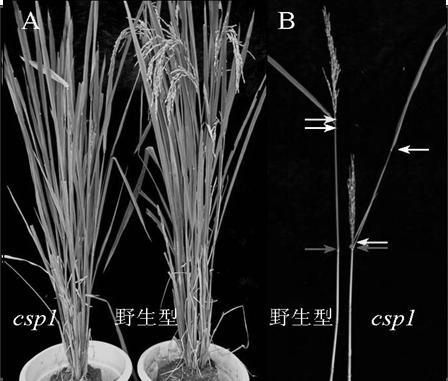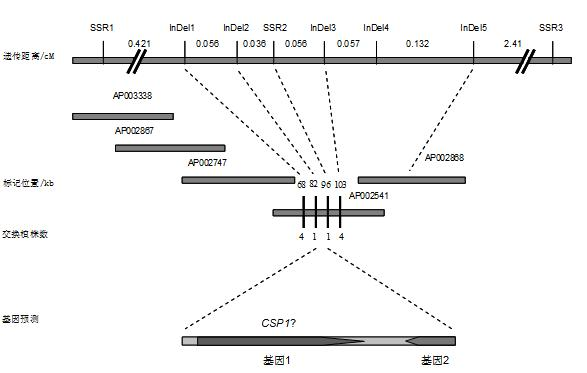Control gene of rice panicle pedicel length and application thereof
A technology of spike and stem node and gene, applied in the field of rice spike stem node length control gene CSP1
- Summary
- Abstract
- Description
- Claims
- Application Information
AI Technical Summary
Problems solved by technology
Method used
Image
Examples
Embodiment 1
[0035] Embodiment 1: rice panicle stem node length control gene CSP1 Bitcloning of
[0036] 1. Rice material:
[0037] Rice ( Oryza sativa L) Mutant csp1 , the original wild-type material is Minghui 86. The mutant was obtained by the present inventors from the offspring of Minghui 86 immature embryo tissue culture regenerated plants.
[0038] 2. Analyze and target groups:
[0039] mutant csp1 Crossed with the wild-type variety Xiushui 13, F 1 F2 populations were obtained by selfing in the first generation, and 2720 individuals were selected at the heading stage csp1 Plants with mutant phenotypes were used as the targeting population. At the heading stage, about 1 gram of leaves were taken from each plant to extract the total DNA.
[0040] 3. Mapping using rice microsatellite markers (RM and SSR) and InDel markers CSP1 Gene:
[0041] The total DNA of rice was rapidly extracted by the rice micro-method. Take about 0.3 grams of rice leaves, put them into a 1...
Embodiment 2
[0048] Example 2 Genetic Transformation
[0049] According to the sequence of the indica rice Minghui 86 gene, the pCAMBIA1301 vector was used to construct the following Figure 4 shown CSP1 Candidate Gene Complementation Experiment Vector pCAMBIA1301- CSP1 . The specific process of vector construction is: design a pair of primers with restriction sites in the candidate phosphatidylserine synthetase gene region and promoter region, use high-fidelity enzymes to perform high-fidelity PCR amplification and sequencing, and select the sequence is completely correct The clones were digested and ligated, and constructed as Figure 4 The indicated expression vector was then transformed into Agrobacterium. The DNA sequence of the complementary vector is 7334bp, including 1932bp before the start codon and 455bp after the stop codon. The primers used to amplify the DNA sequence of the complementary experiment are (the underlined part is the restriction site and the protection base...
PUM
 Login to View More
Login to View More Abstract
Description
Claims
Application Information
 Login to View More
Login to View More - R&D
- Intellectual Property
- Life Sciences
- Materials
- Tech Scout
- Unparalleled Data Quality
- Higher Quality Content
- 60% Fewer Hallucinations
Browse by: Latest US Patents, China's latest patents, Technical Efficacy Thesaurus, Application Domain, Technology Topic, Popular Technical Reports.
© 2025 PatSnap. All rights reserved.Legal|Privacy policy|Modern Slavery Act Transparency Statement|Sitemap|About US| Contact US: help@patsnap.com



